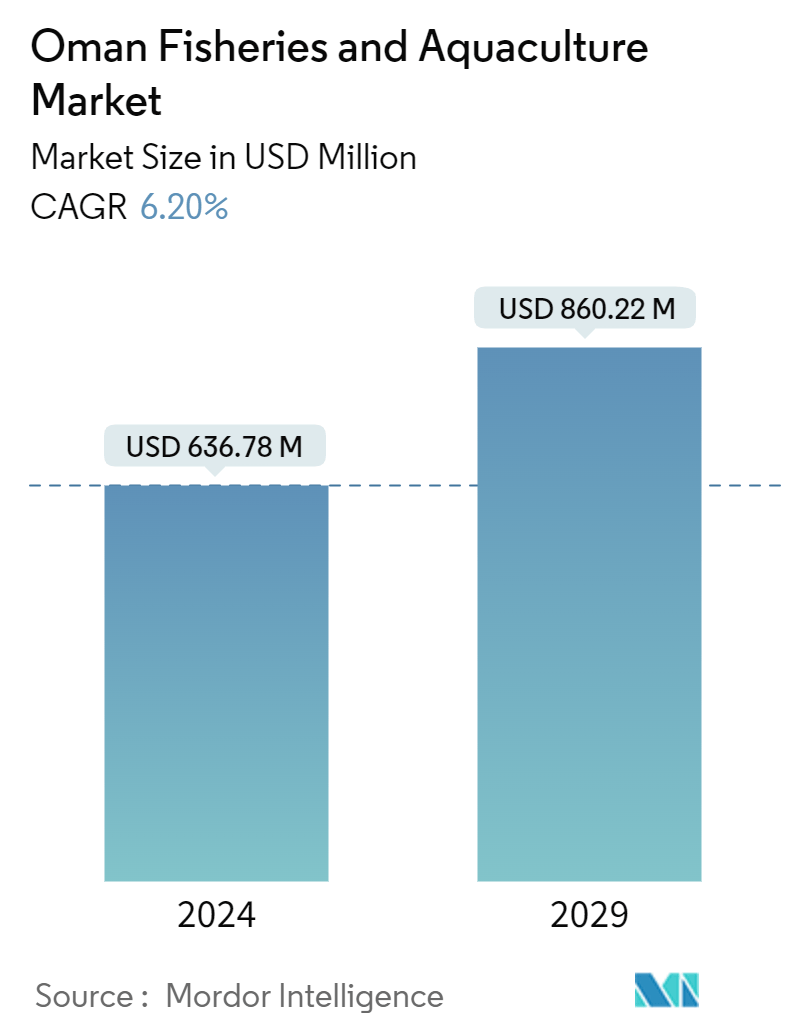Market Size of Oman Fisheries And Aquaculture Industry

| Study Period | 2019 - 2029 |
| Base Year For Estimation | 2023 |
| Forecast Data Period | 2024 - 2029 |
| Market Size (2024) | USD 636.78 Million |
| Market Size (2029) | USD 860.22 Million |
| CAGR (2024 - 2029) | 6.20 % |
Major Players*Disclaimer: Major Players sorted in no particular order |
Oman Aquaculture Market Analysis
The Oman Fisheries And Aquaculture Market size is estimated at USD 636.78 million in 2024, and is expected to reach USD 860.22 million by 2029, growing at a CAGR of 6.20% during the forecast period (2024-2029).
- The aquaculture industry is the most important and oldest in Oman. The Sultanate of Oman has identified aquaculture as a key pillar of diversifying its national economy. The overall vision of the Ministry of Agriculture & Fisheries is to develop a sustainable, competitive, and environment-friendly aquaculture sector that meets the needs of customers from high-quality aqua products. Currently, the Ministry for Agriculture and Fisheries focuses on increasing aquaculture production to 2,20,000 metric tons, with a value of USD 883 million by 2030. Oman's environmental advantage provides a high potential for aquaculture development, and the government is strongly committed to developing this sector competitively and sustainably in harmony with the country's social, economic, cultural, and historical values.
- Besides, Oman is one of the largest fish producers in the Middle East region and a net exporter of fish and fish products. According to the Ministry of Agriculture, Fisheries, and Water Resources, farmed fish production surged to 4,767 metric tons in 2023 from 3,179 metric tons in 2022. Further, Oman-origin fish products, including fresh, chilled fish, frozen fish, value-added fish products, fish meal, and fish oil, are exported to 40 countries, including Europe, the United States, and the Far East, besides the Middle East regularly, and is a major contributor to Oman’s national economy. Hence, the production and export of the aquaculture sector in the country are increasing.
Oman Aquaculture Industry Segmentation
Aquaculture is the practice of farming aquatic organisms, including fish, mollusks, and crustaceans. The commercial production of aquatic species, namely, fish (pelagic fish types, demersal fish types, freshwater fish types, caviar, and salmon) and other edible aquatic species (scallops, shrimp, lobsters, and other species) produced through the country's fisheries and aquaculture sector have been considered for the market study. The Omani fisheries and aquaculture market is segmented by type (pelagic fish, demersal fish, freshwater fish, scallops, shrimp, lobsters, caviar, and other types). The report offers the market size and forecasts in terms of volume (metric tons) and value (USD) for all the above segments.
| By Type | ||||||
| ||||||
| ||||||
| Freshwater Fish | ||||||
| Scallop | ||||||
| Shrimp | ||||||
| Lobsters | ||||||
| Caviar | ||||||
| Other Types |
Oman Fisheries And Aquaculture Market Size Summary
The aquaculture industry in Oman is poised for significant growth, driven by the country's strategic advantages and government initiatives. As one of the largest fish producers in the GCC region, Oman plays a crucial role in the fisheries and aquaculture sector, which is the oldest and most vital industry in the country. The government's commitment to enhancing this sector is evident through programs like the Oman Aquaculture Development Company (OADC) under the National Food Security Program. These efforts aim to increase production substantially, leveraging Oman's environmental benefits and resource biodiversity along its extensive coastline. The sector's growth is further supported by Oman's thriving economy, rising population, and status as a popular tourist destination, which collectively boost the demand for quality food products.
The market dynamics in Oman are influenced by various factors, including population growth, changing dietary preferences, and the strategic location near stable export regions. The demand for demersal fishes, such as grouper and trevally, highlights the importance of aquaculture in sustaining local fish populations, especially as certain species face extinction. The Muttrah fish market serves as a central hub for production, with most fish consumed locally and some exported to neighboring countries. The increasing local demand, driven by population growth and a shift towards more seafood in diets, is expected to propel the aquaculture market forward. Despite challenges posed by the COVID-19 pandemic, which disrupted market forces, the sector is set to recover and expand, supported by government policies and the country's natural advantages.
Oman Fisheries And Aquaculture Market Size - Table of Contents
-
1. MARKET DYNAMICS
-
1.1 Market Overview
-
1.2 Market Drivers
-
1.2.1 Increase In Sales Via E-Commerce Platform Influenced by Social Network
-
1.2.2 Adequate Support from The Government and Other Associations
-
1.2.3 Rising Demand for Fish
-
-
1.3 Market Restraints
-
1.3.1 Major Disease Outbreaks in Fisheries
-
1.3.2 Extreme Meteorological and Hydrological conditions
-
-
1.4 Value Chain Analysis
-
1.4.1 Value Chain Overview
-
1.4.2 Price Markups in the Value Chain
-
1.4.3 Value Chain Issues and Challenges
-
-
1.5 PESTLE Analysis
-
-
2. MARKET SEGMENTATION
-
2.1 By Type
-
2.1.1 Pelagic Fish
-
2.1.1.1 Sardines
-
2.1.1.2 Mackerel
-
2.1.1.3 Tuna
-
2.1.1.4 Barracuda
-
-
2.1.2 Demersal Fish
-
2.1.2.1 Grouper
-
2.1.2.2 Trevally
-
2.1.2.3 Emperor
-
2.1.2.4 Pomfret
-
-
2.1.3 Freshwater Fish
-
2.1.4 Scallop
-
2.1.5 Shrimp
-
2.1.6 Lobsters
-
2.1.7 Caviar
-
2.1.8 Other Types
-
-
Oman Fisheries And Aquaculture Market Size FAQs
How big is the Oman Fisheries And Aquaculture Market?
The Oman Fisheries And Aquaculture Market size is expected to reach USD 636.78 million in 2024 and grow at a CAGR of 6.20% to reach USD 860.22 million by 2029.
What is the current Oman Fisheries And Aquaculture Market size?
In 2024, the Oman Fisheries And Aquaculture Market size is expected to reach USD 636.78 million.

